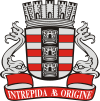João Pessoa
| João Pessoa | |||
| — Municipality — | |||
| The Municipality of João Pessoa | |||
|
|
|||
|
|||
| Nickname(s): Green City; The City where the sun rises first | |||
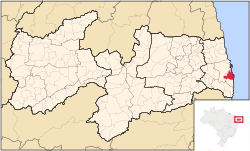 |
|||
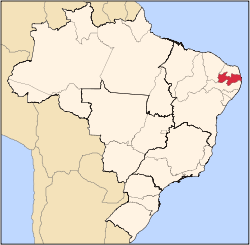 |
|||
| Country | |||
|---|---|---|---|
| Region | Northeast | ||
| State | |||
| Founded | August 5, 1585 | ||
| Government | |||
| - Mayor | Ricardo Coutinho (PSB) | ||
| Area | |||
| - Total | 210,45 km² (81,25 sq mi) | ||
| Elevation | 40 m (131 ft) | ||
| Population (2007)[1] | |||
| - Total | 674,762 | ||
| - Density | 3.146,6/km² (1,214,9/sq mi) | ||
| Time zone | Central (UTC-3) | ||
| HDI (2000) | 0.783 – medium | ||
| Website: João Pessoa, Paraíba | |||
João Pessoa (pronounced [ʒuãũ pesoɐ]), formerly Parahyba do Norte in 1917 and sometimes called the city where the sun rises first, is a Brazilian city and the easternmost city in the Americas at 34º47'38"W, 7º9'28"S. Local residents call its easternmost point Ponta do Seixas. It is also considered "the second greenest city in the world". The city has more than 7 square kilometres (2.7 sq mi) of forested land, losing only to Paris in France. It gained this distinction in 1992, after a survey of urban centres in various countries carried out by the United Nations (source: Embassy of Brazil in the UK). The city is characterized by the juxtaposition of tropical beaches, modern architecture and historic buildings from colonial periods.
João Pessoa is the capital of Paraíba, a state in the northeast region of Brazil and home to some of the most noted Brazilian poets and writers such as Augusto dos Anjos (1884-1908), José Américo de Almeida (1887-1980), José Lins do Rego (1901-1957) and Pedro Américo (1843-1905) (mostly known for his historical paintings). It took its current name in 1930 as a homage to state president (governor) João Pessoa Cavalcanti de Albuquerque, who was assassinated on 26 July of that year. It is the state's largest and most important city, with a population of about 672,000 (about one sixth of the state's population - 2006 estimate). Its metropolitan area comprises eight other satellite cities (Bayeux, Cabedelo, Conde, Lucena, and Santa Rita) and about 384,000 people, reaching more than 1 million inhabitants in the metropolitan area.
It is the capital with the shortest distance from another capital (Recife, PE) which is around 120 kilometres (75 mi) away, as well as Natal, RN, 180 kilometres (110 mi) North of João Pessoa. Due to the high growing rate of these three capital cities, it is believed that for the next few decades an informal megalopolis will be set up, especially between Recife and João Pessoa.
The capital of Paraíba is one of the oldest in the northeast of the Country. Big theatres, auditoriums and convention centres are part of the available infrastructure in the city; ready to host the most varied types of events and business meetings.
The new Presidente Castro Pinto International Airport connects João Pessoa with many Brazilian cities and also operates some international flights.
The new ESTAÇÃO CIÊNCIA, CULTURA e ARTES (Science, Culture and Art Station)[2] located at the most eastern point of the Americas (Ponta dos Seixas) is both an educational and cultural institution as well as a national landmark. The complex, inaugurated in 2008, was created by world renowned Brazilian architect Oscar Niemeyer and is one of his latest projects.
Contents |
History
João Pessoa is one of the oldest cities in Brazil and was founded by the Portuguese in 1585 after wars against the local Indians and the invading French. It had a stormy history and came under Spanish influence when Spain and Portugal were briefly united in the Iberian Union (1580-1640). It was also held by the Dutch for around 20 years in the 17th century. Its name has changed several times and its current name, literally translated as "John Person", dates from 1930. The city's name was altered from Paraiba as a tribute to an assassinated local politician.
In the 16th century, Portuguese settlers from Pernambuco founded Filipéia de Nossa Senhora das Neves (today João Pessoa) at the mouth of the Paraíba River. The area soon proved perfect for sugar production, with the French, the Dutch and the Portuguese all constantly fighting to control the Paraíba region to grow the lucrative sugarcane in. The fortress of Santa Catarina, near João Pessoa, was built by the Portuguese to protect the city from the invading Dutch, who soon became the greatest threat to Portuguese supremacy in Portugal's Colonial Brazil. The Portuguese Empire managed to protect the integrity of the territoriy of Brazil, which become independent from Portugal in 1822.
Geography
| for João Pessoa | |||||||||||||||||||||||||||||||||||||||||||||||
|---|---|---|---|---|---|---|---|---|---|---|---|---|---|---|---|---|---|---|---|---|---|---|---|---|---|---|---|---|---|---|---|---|---|---|---|---|---|---|---|---|---|---|---|---|---|---|---|
| J | F | M | A | M | J | J | A | S | O | N | D | ||||||||||||||||||||||||||||||||||||
|
47
32
23
|
61
30
23
|
96
30
23
|
146
30
22
|
175
30
22
|
233
28
22
|
184
27
20
|
119
28
22
|
47
28
22
|
33
29
22
|
24
30
23
|
20
30
23
|
||||||||||||||||||||||||||||||||||||
| temperatures in °C precipitation totals in mm source: MSN Weather |
|||||||||||||||||||||||||||||||||||||||||||||||
|
Imperial conversion
|
|||||||||||||||||||||||||||||||||||||||||||||||
Climate
João Pessoa has a typical tropical climate, with warm to hot temperatures and high relative humidity all throughout the year. However, these conditions are relieved by a near absence of extreme temperatures and pleasant trade winds blowing from the ocean. Rainfall is heavy at around 1,800 millimetres (71 in) per year, though there is a fairly dry period from about October to January. The wettest months are from April to July when moist southeasterly winds are strongest and are uplifted by the escarpment.
Environment
João Pessoa has approximately 40 kilometres (25 mi) of beaches (both residential and virgin) as well as many small, natural islands. The Brazilian Ministry of Tourism (BMT) notes that "on the outskirts of the capital are the most popular beaches in the State, such as Tambaú and Manaíra. Nearby it is possible to find one of the few Brazilian nudist beaches (naturism) that is officially recognized, Tambaba." In addition, BMT emphasizes that it is "full of parks and avenues which abound with fruit and ornamental trees; João Pessoa has many forest reserves, where one can find the coconut tree and man y other species of tree which constitute the coastal woodland landscape that attracts thousands of tourists every year."
João Pessoa has many green areas distributed among its avenues, parks, and residential neighborhoods, which all make it very pleasant and support its claim to be "the second greenest city in the world" with more than 7 square kilometres (2.7 sq mi) of forested land, second only to Paris. It was considered thus in 1992, after a survey of urban centres in various countries carried out by the United Nations (source: Embassy of Brazil in the UK).[3]
Worldpress.org notes that "João Pessoa is full of preserved natural forests, squares and gardens, which is why it is considered one of the cities with the highest index of green area per inhabitant in the world. Another beauty of the city is the Ponta do Seixas, the easternmost point of the Americas, which can be seen from the majestic Farol do Cabo Branco (Cabo Branco Lighthouse)" and "natural pools of Picãozinho on the island Areia Vermelha."
Vegetation
João Pessoa has a Tropical forest. Rainforests are characterized by high rainfall, with definitions setting minimum normal annual rainfall between 2,000 millimetres (79 in) and 1,700 millimetres (67 in). The soil can be poor because high rainfall tends to leach out soluble nutrients. There are several common characteristics of tropical rainforest trees. Tropical rainforest species frequently possess one or more attributes not commonly seen in trees of higher latitudes or trees in drier conditions on the same latitude.
Education and Culture
The official language is Portuguese, and the dialectal differences are mainly phonological. Portuguese is the primary language taught in schools. But English and Spanish are part of the official high school curriculum.
Higher Education
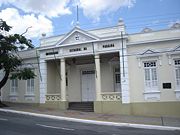
The city is home to the Federal University of Paraíba and several other universities and faculties. Below are some of the higher education institutions at João Pessoa:
- Universidade Federal da Paraíba (UFPB);
- Paraíba State University (UEPB);
- João Pessoa University Center (UNIPÊ);
- Paraíba Institute of Higher Education (IESP);
- Federal Center for Technological Education (CEFET-PB);
- Maurício de Nassau College (FMN);
- Paraíba Medical Sciences College (FCM);
- Nova Esperança College of Medicine (FAMENE);
- and many others.
Cultural Centers
Espaco Cultural Espaco Cultural is one of the largest arts centers in the northeast of Brazil. It features modern architecture and is a major cultural venue for the state. Its architectonic complex includes a live concert plaza, convention facilities, movie theater, play theater, art gallery, planetarium, craft stores, and more.
Estacao Ciencia, Cultura e Artes (Science, Culture and Art Station) [in progress] A project entitled ESTAÇÃO CIÊNCIA, CULTURA e ARTES (Science, Culture and Art Station)[4] by world renowned Brazilian architect Oscar Niemeyer was recently inaugurated at Ponta do Seixas. The center provides a wide range of cultural and educational activities for locals and turists.
Infrastructure
International Airport

The city is served by Presidente Castro Pinto International Airport, located in the municipality of Bayeux, eight kilometers from downtown João Pessoa, and currently undergoing expansion and remodeling work, which will raise the terminal's annual capacity to 860 thousand passengers.
Urban transportation
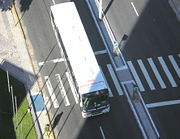
In the city, public transportation is mostly based on a private bus system, taxis and railways. The city has approximately 500 buses. A single passenger ticket can be used to travel around town and to make connections. There's a major terminal (Terminal de Integração do Varadouro) where passengers can change buses. An electronic ticketing system is being implemented to offer better efficiency to passengers. Currently the bus fare is R$ 1,70, or approximately $ 1 USD, (as of 2008). Extended time or trips in taxis can often be negotiated directly with the driver. For example, a taxi from Campina Grande to João Pessoa, about two hours away, can be taken for about R$ 40, or $ 24 USD, depending on the exchange rate.
Railway
The railway system provides inter-city commuting for people from cities in the metropolitan area only in parts of the western and northern area of the capital.
Distances
- Recife: 125 kilometres (78 mi)
- Natal: 180 kilometres (110 mi)
- Fortaleza: 688 kilometres (428 mi)
- Salvador: 944 kilometres (587 mi)
- Brasília: 2,338 kilometres (1,453 mi)
Economy
The GDP for the city was R$ 5,024,604,000 (2005).[5]
The per capita income for the city was R$ 7,604 (2005).[6]
Tourism, Culture and Recreation
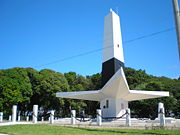
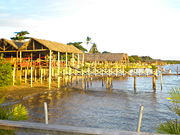
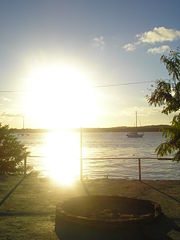
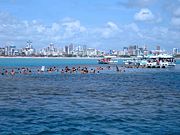
João Pessoa is located in the most eastern point of the Americas and is the second greenest city in the world. Coupled with that, the city has 40 km of tropical beaches. Consequently, tourism is one of João Pessoa's chief economic activities, together with construction, food, metalworking, and other industries. Sugar cane agriculture and related industries are also important. Historically, Tarcisio de Miranda Burity, a former governor, has made major strides to improve the infrastructure of the city and to support the arts. Today, João Pessoa has a growing turistic and commercial industry. In fact, the second largest Mall in the Northeast region of Brazil, namely Shopping Manaira, is located in Joao Pessoa.
João Pessoa has one publication which highlights its touristic attractions: The Guia Mais Joao Pessoa [7]. Major local newspapers, such as O Correio da Paraiba and O Norte, highlight a wide range of events on a weekly basis. Below are a few of the major attractions.
Historical sites
Barroco Park It is formed by the colonial mansions scattered around the upper and lower regions of the city.
Theatro Santa Roza A building from 1889, this theatre was decorated in baroque style. It is one of the oldest theatres in the Country. It is located at Pedro Américo Square.
Redenção Palace Erected in 1586, Redenção Palace used to be the home of the old Jesuits convent. Today the building is the State Government headquarters.
Santa Catarina Fortress The fortress built in 1586 comprises the captain's house, a chapel and cannons from the XVI century.
Saint Francis Church and Saint Anthony Convent Totally embellished in baroque style, the church and the convent were built in 1589 and 1779, respectively. The highlights are the chapels of the Third Order of Saint Francis and Saint Benedict, featuring Portuguese ceramic panels and sacristy. The spaces also feature, regularly, popular art exhibitions.
São Frei Pedro Gonçalves Church Erected in 1843, the church was restored in 2002 and features the foundations from the old XVII century building. In front of it there are many restored colonial mansions.
Parks
Solon de Lucena Park Located at the commercial centre of the paraibana capital, Solon de Lucena Park, also known as "Lagoa", is filled with centenary imperial palm trees, golden trumpet trees and acacias – the tree symbol of the city. At the centre there is a luminous fountain.
Arruda Câmara Park Also known as "Bica", because of an old mineral water fountain, it features a zoo, botanic garden and leisure areas.
Monuments
Cabo Branco Lighthouse It is located at the easternmost inland point in the Country and allows panoramic views of the city; from there all the Ponta do Seixas beach can be seen.
Museums
Museum of Cultural Center of Saint Francis Permanent exhibition of Religious and Baroque Art. Also, the center offers contemporary art and craft exhibitions. Located in the site of Saint Francis Church.
José Lins do Rego Museum Located at Espaço Cultural, the museum has a library of over 4000 volumes, photos, letters, honors, manuscripts, and personal objects of Rego, a major paraibano writer.
Casa do Artista Popular The museum has over 1000 works of crafts representing a wide range of styles developed in the state of Paraiba. The museum also has library and gift shops.
Espaço Energia This museum takes its visitor to the history of electricity. The museum shows the types of energy used in the 19th century and ends its display with a contemporary home, fully equipped with electrical appliances and such. Housed at Usina Cultural da Saelpa.
Ocean Museum of Cabedelo A collection that highlights the remaining of ships that sank in the area.
Augusto dos Anjos Memorial Located in Sapé, about 50 kilometres (31 mi) from João Pessoa, the memorial allows visitors to immerse in the house where this noted paraibano writer lived his childhood and part of his adulthood.
Epitácio Pessoa Museum (Museu e Cripta de Epitácio Pessoa). The museum houses objects from former Brazilian president Epitácio Pessoa.
Historic Archive of the State of Paraíba (Arquivo Historico do Estado da Paraiba). Preserves the historic heritage of the state.
José Américo de Almeida Museum (Museu José Américo de Almeida). The house where lived this noted political figure and write Minister José Américo de Almeida.
Theatres
- Santa Rosa Theatre
- Paulo Pontes Theatre in Espaço Cultural
- Theatre of Arena in Espaço Cultural
- Lima Penante Theatre
- Ednaldo do Egypto Theatre
- Ariano Suassuna Theatre
- Sala de Cultura in Shopping Sul
Movie Theaters
- Box Cinemas in Manaíra Shopping
- Multiplex Mag 5 in Mag Shopping
- Mutiplex Tambiá 4 in Tambiá Shopping
- Cine Bangüe in Espaço Cultural
Major Art Galleries
- Galeria Gamela
- Nucleo de Arte Contemporanea (NAC)
- Galeria Usina Cultural Saelpa
- Centro Cultural Sao Francisco
- Galeria Archidy Picado - Espaço Cultural
- Louro e Canela Arte Contemporanea
- Casarao 34
- Galeria de Arte - Zarinha Centro de Cultura
Artists' Studios open for visitation
- Atelie Miguel dos Santos
- Atelie Clovis Junior
- Atelie Flavio Tavares
- Casa Experimental de Arte (Sidney Azevedo, Alena Sa, and Dyogenes Chaves)
Events and Entertainment
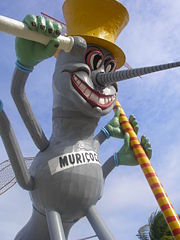
Muriçocas do Miramar (Feb) Main street carnival held in the wednestay prior to official carnival days.
Vem Viver a Paraíba (Jan - Feb) "Come and Experience Paraiba" is a tourism fair and folklore performance event.
Centro em Cena (Jan) Art and culture event.
Folia de rua - Prévia Carnavalesca (Feb) Street carnival a few days prior to official carnival days.
Carnaval da Melhor Idade (Feb) Carnival for senior citizens.
Auto de Deus (Apr) Passion Play of the crucifixion of Christ.
São João Pessoa - São João fora de época (to be announced) One of João Pessoa’s major regional music events.
Feira Brasil mostra Brasil (Jul) Trade Fair featuring Brazilian products.
Festa das Neves (Aug) Religious Celebration of the Patroness of the City: Santa Maria Maggiore.
FENART João Pessoa (Nov) Major fine arts exhibition in the area.
Vaquejada do Cowboy (Nov) Rodeo-inspired event.
Festa do Atum (Dec) Popular festival dedicated to the tuna.
Reveillon (Dec 31) New-Year’s Eve festivities and fireworks at the beach.
Sports
João Pessoa provides visitors and residents with various sport activities.
Stadiums
- José Américo de Almeida Filho Stadium;
- Evandro Lélis Stadium.
Gymnasium
- Ronaldo Cunha Lima Gymnasium.
Soccer Clubs
- Centro Sportivo Paraibano;
- Auto Esporte Clube;
- Botafogo.
Sister cities
João Pessoa's siter cities are:
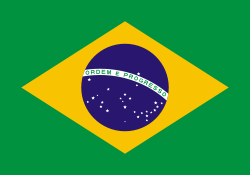 Aracaju, Brazil
Aracaju, Brazil Salvador, Brazil
Salvador, Brazil Maceió, Brazil
Maceió, Brazil Recife, Brazil
Recife, Brazil Hartford, USA
Hartford, USA Tucson, USA
Tucson, USA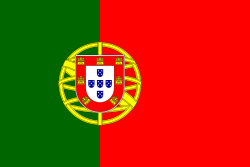 Coimbra, Portugal
Coimbra, Portugal Lisboa, Portugal
Lisboa, Portugal
Gallery
References
- ↑ [IBGE - 2006]
- ↑ (in Portuguese) (PDF)ESTAÇÃO CIÊNCIA, CULTURA e ARTES. joão pessoa, Brazil: E.C.C.A.. 2006. ISBN 85-240-3919-1. http://www.joaopessoa.pb.gov.br/projetos/estacaocienciaculturaartes/. Retrieved on 2008-01-10.
- ↑ (PDF)Green City. joão pessoa, Brazil: UK Embassy. 2006. ISBN 85-240-3919-1. http://www.brazil.org.uk/page.php?n=354. Retrieved on 2008-01-10.
- ↑ (in Portuguese) (PDF)ESTAÇÃO CIÊNCIA, CULTURA e ARTES. joão pessoa, Brazil: E.C.C.A.. 2006. ISBN 85-240-3919-1. http://www.joaopessoa.pb.gov.br/projetos/estacaocienciaculturaartes/. Retrieved on 2008-01-10.
- ↑ (in Portuguese) (PDF)GDP. João Pessoa, Brazil: IBGE. 2005. ISBN 85-240-3919-1. http://www.ibge.gov.br/home/estatistica/economia/pibmunicipios/2005/tab01.pdf. Retrieved on 2007-07-18.
- ↑ (in Portuguese) (PDF)per capita income. João Pessoa, Brazil: IBGE. 2005. ISBN 85-240-3919-1. http://www.ibge.gov.br/home/estatistica/economia/pibmunicipios/2005/tab01.pdf. Retrieved on 2007-07-18.
- ↑ Guia Mais Joao Pessoa 01.01.2008
External links
Photography
- Aerial view of João Pessoa by Dirceu Tortorelo
- Virtual Tourist Members’ Pictures of João Pessoa
- Tambau Hotel: An Architectural Landmark
- 50 Pictures of Joao Pessoa and local area
- Photos of Joao Pessoa and regional music by Gilberto Gil, Brazilian Minister of Culture and singer
Related Wiki links
- João Pessoa travel guide from Wikitravel
Links
Video
- Official Promotional video of João Pessoa | English
- Official Promotional video of João Pessoa | Portuguese
|
||||||||||||||||||||||||||
|
|||||||||||||||||||||||||||||
|
||||||||||||||||||||
|
|||||

